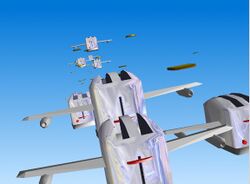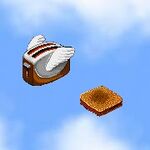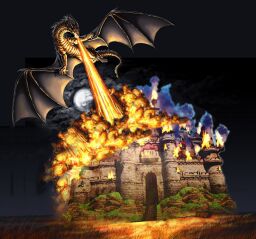Flying toasters
Originally developed by the military for use in reconnaissance, it rapidly became apparent to all that flying toasters were far more useful for delivering provisions to captured or trapped soldiers than they were as spies, due partly to a number of handicaps from which the toasters suffered which interfered with their abilities as spies. Notable among their drawbacks were a lack of eyes, ears, or other senses which would have allowed them to actually learn anything, as well as their innate lack of brain which would have prevented them from remembering anything had they actually learned it.
Emergency delivery of provisions
Provision delivery worked best if the toasters were preloaded with toast, which gave them something to deliver. Alternatives such as suspending a backpack under the toaster using ropes proved less effective, both because the dangling objects tended to get picked off by passing birds (particularly if the birds were hungry and the suspended packs contained food), and because the toasters in flight tended to get hot and burn through the ropes unless they were very carefully positioned.
Passenger Toasters
Later expansion in toaster size allowed the toasters to carry more than one person at a time, and even later development of insulated passenger compartments made it possible for the toasters to carry more than one person who was not made of asbestos at one time. The latter proved to be an enormous step forward in the utility of the flying toasters, as it turned out, when passenger carrying toasters were first put in service, that a surprisingly small percentage of military personnel are made of asbestos. A number of experiments which ended rather badly were enough to demonstrate that the majority of military personnel (at least those who participated in the experiments) were ill suited to traveling in a cabin whose temperature while in flight exceeded 400 degrees Fahrenheit.
Wind power
The final development in the realm of the Flying Toasters was the conversion to the use of wind power. Previous generations of toasters had been limited in range, being unable to fly farther than the length of the extension cords into which they were plugged. In fact, that had severely limited their utility in a number of applications. Just to name one example, the number of intercontinental passenger airline routes which could be flown by the toasters had been limited to those which are no longer than 150 feet long, and there aren't very many of them. With wind powering, however, it became possible for them to fly as far as they liked, as long as they avoided areas without air. Of course, a wind powered toaster requires wind, not just air, but in fact it only requires what we might call an externally generated wind during takeoff. Once airborne, the forward motion of the toaster through the air provides more than adequate wind to power all systems, at least as long as the toaster is moving rapidly. A hovering toaster, on the other hand, requires a rather significant breeze in order to maintain its position.
History
Development of the Modern Flying Toaster
According to classified government documents leaked by Chelsea (Bradley) Manning, padawan of the noted Jedi Knight Edward Snowden, the original flying toasters were reverse-engineered from remains gathered at the supposed crash site of a fallen angel.[1] Information are sparse in the documents which were obtained, but given the fact that many Bothans died during the attempt, most authorities on the matter[2] are quite grateful for what little they have.
The bits and pieces recovered from the crash were, according to the records, submersed in holy water, loaded on to flatbed trucks, and transported to California in the hopes that the ubiquitous earthquakes would help prevent the appendages of the angelic being from re-assembling in a process known as "Immortality".
The documents also implicate an unknown "Beerkelley Labs", stating that it was this organization charged with performing most of the actual research and testing; it is a proven fact that most governments are incompetent, and the self-titled United States is no exception. No evidence of a Beerkelley has yet been uncovered, but it is probable that this nomer was, in fact, a misnomer or "code name" used to maintain secrecy and plausible deniability in the event that their hazardous work created any hazardous conditions.[3]
Sightings of these modern flying toasters of the antique variety were most frequently reported from the years 1989 to 1998, although occasional reports have continued since. These sightings were often accompanied by an annoying flapping sound, and that the aerial craft seemed to favor areas with greater population density of the indigenous personal computers, especially those which subsisted on a diet rich in apples.
Pre-Industrial Flying Toasters
Though the electrical flying toaster is a modern invention -- as is, for that matter, the electrical any-other-kind-of toaster -- we shouldn't leap to the conclusion that toasters are also a modern invention.
In fact, toasters, as in things which toast things, were invented much earlier, and in fact flying toasters, as in things which fly and toast things, entered human history long before Edison and his lightbulb were even conceived of.
Flying toasters were a particularly severe problem for towns in fairy tales. The most famous of the flying toasters which plagued such towns may have been Smaug, who thoroughly toasted the town of Dale, as you may recall (assuming your teachers didn't neglect such fine points during your early education).
There are, however, a number of significant differences between modern flying toasters and the historic variety.
One major difference between latter day (electrical and wind powered) flying toasters and the earlier organic flying toasters is the use to which humans put them. The modern variety is used by humans as a form of transportation, while the earlier versions were mostly used to accumulate experience points in Dungeons and Dragons games. Another difference is that modern toasters never steal treasure and pile it all up in a heap in a big cavern somewhere so they can spend most of their time sleeping on it. And finally, modern flying toasters hardly ever talk, unlike the older variety, which was known for its clever speech and fondness for riddles.
References
Do Not Remove From Library
- ↑ Haberdasher, Chancé. "Scandalously Unscrupulous Immorality Given 'Thumbs Up' in Associate Secretaries of State Meeting Thursday", The Global Gobbledygooker, December 22, 2012.
- ↑ See to the dossiers of Richard Apperhuois, Caitlynn Tayton, and Gandhi's pet Brahman.
- ↑ Refer to the real-life events documented in the epic saga, Halve-Life, Will Travel: A Black Mason's Tale, which was later adapted to a computer game and significantly altered to meet market profiles.
| Featured version: 8 December 2014 | |
| This article has been featured on the main page. — You can vote for or nominate your favourite articles at Uncyclopedia:VFH. | |





